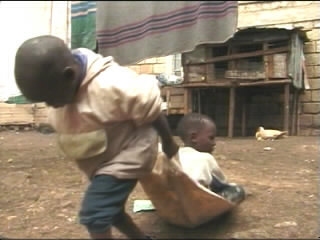Orphans of Mathare
The Good Samaritan Children's Home in the slums of Nairobi is little more than a shack. There's no water or sanitation and it's staffed entirely by local volunteers. But for the children of the slums, it's their only refuge.
 This week's documentary is a fly on the wall account of life in an African orphanage. The Good Samaritan Children's Home in the slums of Nairobi is little more than a shack. The walls are made of corrugated iron, there's no water or sanitation and it's staffed entirely by local volunteers. But for the children of the slums, it's their only refuge. We follow the children over a period of a week as they go to school, play in the street and reflect on their lives. This character-led, classic documentary provides an intimate portrait of life in the orphanage.
This week's documentary is a fly on the wall account of life in an African orphanage. The Good Samaritan Children's Home in the slums of Nairobi is little more than a shack. The walls are made of corrugated iron, there's no water or sanitation and it's staffed entirely by local volunteers. But for the children of the slums, it's their only refuge. We follow the children over a period of a week as they go to school, play in the street and reflect on their lives. This character-led, classic documentary provides an intimate portrait of life in the orphanage.
A little boy shivers with cold. He's standing on a stone slab in the orphanage's courtyard covered in soap. But he can't finish washing until his two friends return with a bucket of water. In another section of the courtyard, children are passing round a bottle of water to brush their teeth and a volunteer is gently cutting a boy's hair. It's just a typical morning at the orphanage.
The Good Samaritan Children's Home was founded by 'Auntie' Thuo after children began living in the streets in her neighbourhood. Facilities are basic: the home can barely care for all its children and staff are overburdened. But the children help out whenever they can. Older orphans protect the younger ones and the children entertain themselves. "We don't have shoes but we'll play football as if we had good shoes," they state proudly.
The children know that, were it not for Auntie, they'd be living on the streets. Most of them are AIDS orphans. After their parents died, they slipped through the net of Kenyan social services and ended up on the street. "Life on the streets in so hard," declares 15 year old Chalo. "No one to look after you, to feed you, being rained on..." He lived in the slums for over a year, sleeping under cars and scavenging food from bins. His friend Boss spent three years on the streets. Years of sniffing glue have left Boss permanently brain damaged, leaving him with few prospects.
While Boss, Chalo and the other children play outside, Ochieng languishes in bed. He has typhoid and hookworm and is too weak to move. "I'm dying," he whispers to his sister. The orphanage hopes that the paracetamol prescribed by the local doctor will cure him. Instead, this treatment nearly kills him. His older sister is beside herself with worry. After their parents died they were left alone together. Then she started smoking drugs and working as a prostitute while he sought sanctuary at the Good Samaritan.
Although AIDS is omnipresent, most people have scant understanding of the disease. "They don't know what AIDS is," states Helen, one of the volunteers. "They think maybe there's an evil spirit causing the sickness." Even teenagers like Chalo are reluctant to use condoms. Instead he believes that Christianity will protect him. But as AIDS continues to ravage the country, many traditional beliefs and practices are slowly dissolving. Religion is struggling to provide answers to this new problem, creating a deep sense of uncertainty.
The Good Samaritan is one of several makeshift orphanages in Nairobi trying to provide an African solution to the country's problems. But children at other homes are often in as much danger as if they were on the streets. At the end of the week three new girls arrive at the home. Auntie has been asked to care for them because their previous orphanage was being run by a paedophile. They have been sexually abused and now have venereal diseases. The youngest is just six. But Boss soon takes the girls under his wing, proudly showing them around.
The lives of the children at the Good Samaritan children's home lays bare the complicated relationship between disease and poverty, religion and tradition. Through the eyes of the children, we gradually come to understand their world.
VHS and DVD Sales not available to North America
FULL SYNOPSIS
